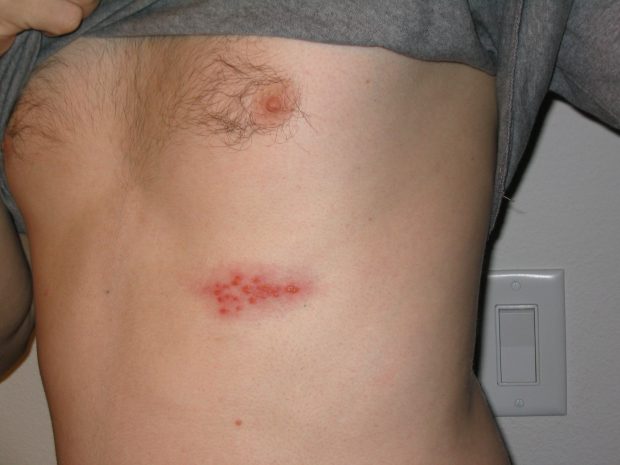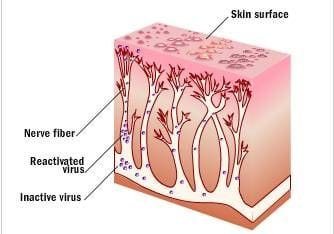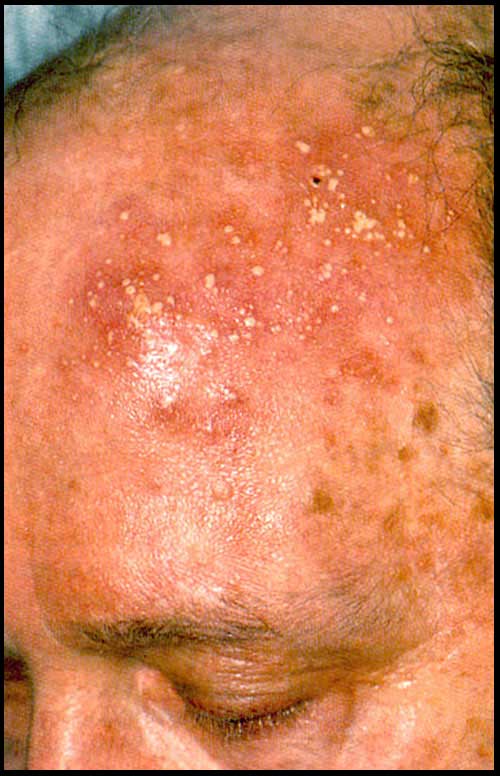Reactivation of latent varicella‐zoster virus is by many predisposing factors, which includes:
- Trauma
- Radiation
- Surgery
- Malignancy (Lymphoma, leukemia or tumor in the dorsal root ganglion).
- Immune suppression.
Reactivation of the latent virus (which was primary chicken pox) results in infection of the posterior root ganglion of spinal cord or extra‐medullary ganglion of the cranial nerve then spreads down the nerve fibers of the skin of the dermatomeleading to vesicular eruption, unilateral, segmental, along the Cutaneous distribution of the nerves.
Affected Nerves
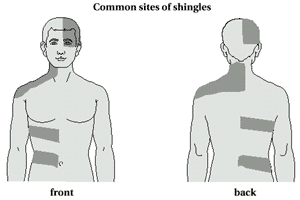 C3, T5, L1, L2 and Ophtahlmtic (1st division of the trigeminal nerves) Less common the facial nerve (wither sensory or nerve)
C3, T5, L1, L2 and Ophtahlmtic (1st division of the trigeminal nerves) Less common the facial nerve (wither sensory or nerve)
Clinical Features
Age: adults and old age.
Rare in children except Child had chicken pox in the first few months of life.
Very Rare Congenital: Mother had chicken pox during early pregnancy infant will suffer from Congenital Varicella Syndrome (Limb deformity, ocular lesion, Extensive scarring, Muscular atrophy, cerebral and psychomotor retardation).
Course: 3‐ 4 weeks.
Prodrome:
Skin Lesion:
- Unilateral and liner papules or vesicles along the dermatomic distribution (skin and mucosa membrane) supplied by the affected nerve.
- The papules or vesicles are surrounded by erythema.
- They contain Clear fluid.
- After a few days, the clear fluid becomes purulent.
- One week later the vesicles rupture forming a crust.
- The Skin lesions are mixed (similar to chicken pox) papules, vesicles, pustules, and crust are present together, why? because it occurs in successive waves.
Healing:
- 3–4weeks.
- Scar formation, why? Due to 2nd infection.
- Scars are painless and sometimes very painful to touch (Hyperalgesia). Scars are diagnostic for postherpetic neuralgia.
Oral manifestations
- May involve one or more branches of trigeminal nerve.
- Vesiclesulcersscarring (Painful and surrounded by erythema).
- May be bilateral lesions in Viremia.
- Confluent and necrotic oral lesions in immune‐suppressed patients.
Affected Divisions of the Trigeminal Nerve:
- Involvement of mandibular division.
- Unilateral lesions.
- Involving cheek, tongue, the vestibule of the lower jaw and Cutaneous lesions extending from the chin to the vertex.
- Involvement of Maxillary division.
- Unilateral lesion.
- Involving hard palate, soft palate, the vestibule of the upper jaw, skin of cheek and sides of the nose.
- Involvement of Ophthalmic division (most common).
- Unilateral lesion.
- Involving cornea, forehead, and eyelid
- Most common (15 – 20 times more than the mandibular division).
Pathogenesis
Identical to herpes simplex viral infection.
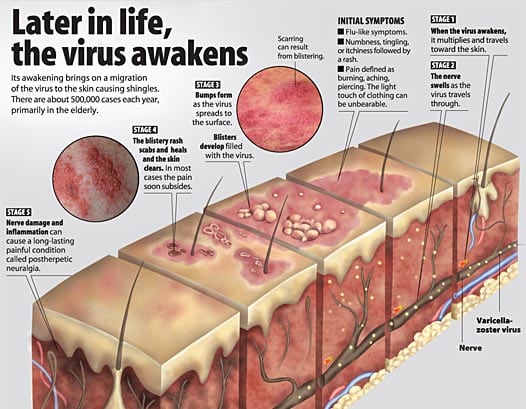
Diagnosis
- Case history (Fever, Prodrome…etc).
- Clinical examination (vesicles and ulcers = Unilateral, along with nerve course, painful).
- Special investigation (same as herpes Simplex)
Treatment
Healthy Patients:
- Mild Clinical Manifestations:
- Sedation.
- Avoid 2nd infection by proper hygiene (0.2% chlorhexidine mouthwash or Rifampicin elixir mouth bath) 4 times daily.
- 5% Acyclovir ointment for skin and eye lesions.
- Topical capsaicin (hot peppers), why?Topical anaesthesia aren’t effective since pain arises from the sensory nerve.
- Sever Clinical Manifestations: 800 mg acyclovir tablets 5 times daily for 7 – 10 days
Disseminated herpes zoster and immune-suppressed patients:
- IV acyclovir 10 mg/kg every 8 hours for 10 days
Elderly patients:
- Acyclovir
- Prednisone 40 – 60 mg/ day Decrease over 3 weeks to prevent post‐herpetic neuralgia
OziDent Members Only
The rest of article is viewable only to site members,Please Register and/ or Confirm registration via EmailHere.If you are an existing user, please login.
